- Submissions

Full Text
Environmental Analysis & Ecology Studies
Qualitative Analysis of the Effect of Heavy Metals, Coliform level and Industrial Activity on Rooftop and Non-Roof Harvested Rainwater in Delta State, Nigeria
Eno-obong Sunday Nicholas* and Pius Onyeoziri Ukoha
Department of Pure and Industrial Chemistry, Faculty of Physical Sciences, University of Nigeria, Nsukka, Nigeria
*Corresponding author:Eno-obong Sunday Nicholas, Department of Pure and Industrial Chemistry, Faculty of Physical Sciences, University of Nigeria, Nsukka, Nigeria
Submission: August 28, 2024; Published: November 22, 2024

ISSN 2578-0336 Volume12 Issue 5
Abstract
Contaminations from natural and anthropogenic activities have really affected the rainwater quality through the effect of high industrial activities and the leaching from roof type components. This led to this study which determined the physico-chemical properties, coliform level, heavy metals of the rainwater/digested roof types. Rainwater was harvested from non-roof (control) and from various roof types in Okpanam Road, Asaba and Warri Refinery Depot, Uvwie, Delta State, Nigeria between April-July, 2018. Heavy metals were analyzed using the Flame Atomic Absorption Spectrophotometer and some other parameters were assessed using standard methods. Descriptive and two-way ANOVA statistical analysis was used for the obtained values. Results were compared with the water quality standards of WHO, USEPA and NSDWQ. The Water Quality Index (WQI) of the rainwater samples was evaluated. The values obtained gave mean values ranging from 6.40-8.80 for pH, E.coli (not detected), heavy metals (mg/L) gave 0.00-0.11 for Fe, Pb(0.00-0.79), Cr (0.00-0.06), Zn (0.01-0.10), Al (0.00-0.81) and metal concentrations (mg/kg) of digested roofs gave 0.00-31.84 (Pb), 0.00-43.45 (Al), 39.22-63.78 (Fe), 0.59-7.04 (Zn) and 1.87-6.20 (Cr). The results showed that all the parameters analyzed were below, within and above the water quality standard and the values were significantly different at (P<0.05). The WQI ranged from 0.05-5,975.77 which rated excellent to unfit for drinking and other domestic purposes. It was concluded that harvested rainwater should be treated before drinking and some helpful recommendations were proposed in this study.
Keywords:Harvested rainwater; Leaching; Toxicity; Atmospheric pollution; Water quality index
Introduction
The world at large is facing water scarcity due to various challenges resulting from increased urbanization and different industrial activities, thus making humans depend on rainwater for their survival, especially those in the rural areas where conventional water supply systems is not available [1-7]. Rainwater is contaminated or polluted by these substances, namely, sulphur dioxide, nitrogen oxides, particulate matter, and heavy metals [8-11] which come from air quality, industrial and traffic emissions and fuel combustion, which can affect the rainwater quality by making it to become toxic [12-16]. Toxicity of the rainwater quality is usually caused by the acidity of the rain [1,17,18]. If acid rain falls depending on the atmospheric pollution of the area, the material used in manufacturing the various roof types can have a negative influence on the quality of the harvested rainwater during catchment [1,19-21]. Catchment or harvesting period of rainwater can lead to the deteriorating and contamination of the water quality [22-24]. Water quality is related to the general environmental status of any area depending on the industrial activities of such an area, as presented by several researchers, which led to water quality index ratings [25- 27]. Water Quality Index (WQI) ratings as per Weight Arithmetic Water Quality Index method gave values from 0-25 for excellent water quality and are graded as “A” and their possible usages are for drinking, irrigation and industrial; 26-50 for good water quality (B) and it is suitable for domestic, irrigation and industrial; 50- 75 for good water quality (C) and it can be used for irrigation and industrial; 76-100 for very poor water quality (D) and can be used for irrigation; Above 100 for unfit for drinking water quality (E) and it is for restricted use for irrigation and proper treatment is required before use [28,29]. Various findings by various researchers have reported that atmospheric pollution can affect the rainwater quality by numerous contaminants that harbour in the air which are from natural occurrences, industries, automobiles as well as the presence of dirt and debris found on the rooftops [30-39]. Since industrial activity can affect the coating materials of the roof to become potent and leach or corrode into the rainwater quality, therefore, there is a need for investigation and assessment, to check if the rainwater quality is in line with the set limits for drinking water quality by NSDWQ, WHO and USEPA [40-42].
Materials & Methods
Standard procedures were used to conduct the analyses to ensure the reliability and accuracy of the results according to the standard methods by AOAC [43]. All the apparatus and sample containers used for the analyses was decontaminated with 10% HNO3 solution and rinsed thoroughly several times with distilled water immediately before use according to the standard methods by AOAC, John-De-Zuane and APHA [43-45].
Sampling areas and their industrial activities
Delta State is the major oil-producing state in Nigeria as a whole. In this research, the study areas were Okpanam Road, Asaba local government and Ekpan Community, Uvwie local government area, and it is where Warri Refinery Depot is situated in Delta State, Nigeria. Okpanam Road, Asaba local government area is populated by offices, hotels and other shopping malls and Ekpan Community, Uvwie local government area is where Warri Refinery Depot is situated, Warri being a great socio-economic city in Delta State and has drawn the attention of people from all walks of life for their various purposes. The industrial activities of these areas can produce enormous effluent bearing acidic gases into the atmosphere, causing pollution (Figure 1).
Figure 1:Sampling map and point of collection.

Sample collection
Rainwater samples were collected between the months of April- July, 2018 from the urban and rural areas of Delta State, Nigeria. Non-roof rainwater from the sky (control) was harvested randomly by placing a sterilized rainwater collector 1-2 meters high above the ground. This technique was used in order to prevent possible contaminations from the ground. The rainwater collector was covered with a sieve having 0.45 micron in diameter in the various sampling point during rainfall out in the open, this was done weekly without any shield on the sky for three weeks to order to constitute triplicate. Once the first rain roofs run-off was flushed out which cleansed the roofs, the rainwater was harvested from the different roof type run-offs on a weekly for three weeks in order to get triplicate.
Analytical Methodology
Analytical reagent grade chemicals were used from Sigma- Aldrich in the USA
Analysis of the collected samples
The collected samples were named as RRWDAU/R-RRWDFU/R and then divided into different portions. The collected samples were later transferred into various sample bottles which were accurately labelled and then firmly tightened and covered to avoid any form of contaminations. Conc. HNO3 (3.0cm3) were added to the collected samples for preservation. These samples were immediately kept in the refrigerator at 4 ˚C after the determination of Total Dissolved Solid (TDS), Electrical Conductivity (EC), temperature, pH at the collection point. Flame Atomic Absorption Spectrophotometer (Flame-AAS) was used for the analysis of heavy metals as described in the standard method. All other parameters analysed were done in accordance to standard methods [43-45].
Control and quality assurance
Standard solution of 1000ppm by Sigma-Aldrich, USA, was used for the spiking and calibration standards. The blank samples and standard solutions were analysed to ensure the results accuracy and precision [46].
Determination of chemical composition of roof type
The determination of the heavy metals composition in the various roof types was done according to standard method by AOAC and APHA [43,45].
Coliform level assessment
Escherichia Coli (E. coli) were determined in the rainwater samples according to the standard method by APHA and AOAC [43,45].
Water Quality Index (WQI)
The WQI ratings was calculated using weighted arithmetic method which categorise the water quality according to the degree of purity using the most frequently measured water quality variables by Nicholas & Ukoha [5]; Noori [47]; Alum & Okoye [48] and it is used by several scientists [49-52].
The calculation of WQI was made by using the following Equation (1) according to Nicholas & Ukoha [5]:

Wn=the weightage unit of each parameter obtained as indicated in Equation (2) according to WHO set limits; Sn=denotes the WHO limits for the nth parameter; qn represents the quality ratings obtained using Equation (3). Vn represents the nth parameter of the given sampling station and Vid is the ideal value of the nth parameter in pure water (Vid for pH=7 and zero (0) for all other parameters).
Statistical evaluation
Values generated in this study were calculated using Microsoft office excel 2010 for mean and Standard Deviation (SD). Software Statistical Package for the Social Sciences (SPSS), version 20.0 was used for the analysis of obtained results using descriptive and twoway ANOVA statistical analysis.
Results & Discussion
Different physico-chemical properties (pH, temperature, TDS, TSS, electrical conductivity, colour, turbidity, phosphate, sulphate and nitrate), heavy metals (Fe, Zn, Cr, Pb and Al) and coliform level (E. coli) were examined and the obtained results are shown in Table 1-3 & Figures 2-8 and the WQI ratings in Table 4.
Table 1:Heavy metals, Physico-chemical properties and coliform level of roofs run-off and non-roofs harvested rainwater in Delta State, Nigeria.
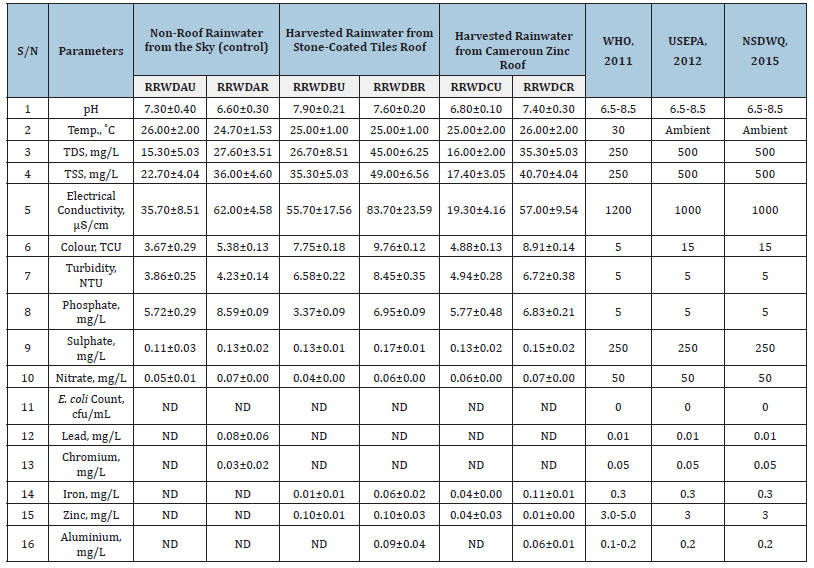
RRWDDU, RRWDEU, RRWDFU-Okpanam Road, Asaba L.G.A; RRWDDR, RRWDER, RRWDFR -Warri Refinery Depot Area, Ekpan Community, Uvwie L.G.A; ND - No Detection
Table 2:Heavy metals, Physico-chemical properties and coliform level of rooftop run-offs and non-roof harvested rainwater in Delta State,
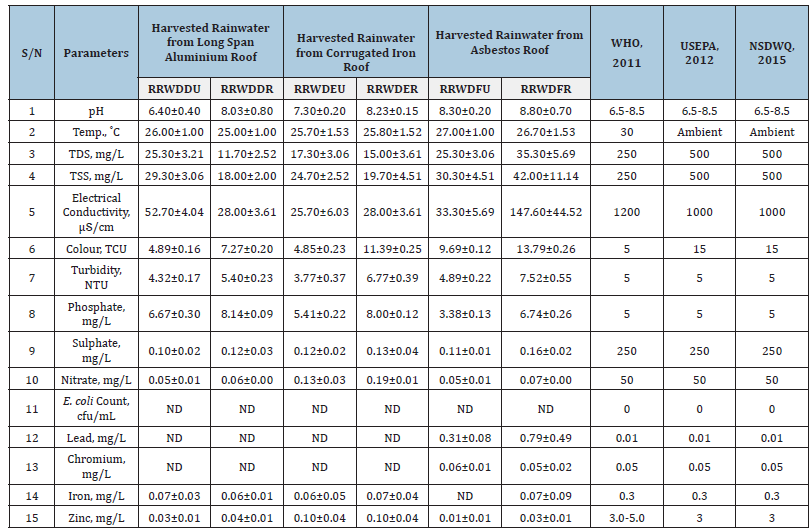
RRWDDU, RRWDEU, RRWDFU-Okpanam Road, Asaba L.G.A; RRWDDR, RRWDER, RRWDFR -Warri Refinery Depot Area, Ekpan Community, Uvwie L.G.A; ND - No Detection.
Table 3:Metals concentrations of the digested roof types.

Figure 2:pH values of analyzed samples in Delta State, Nigeria.

Figure 3:Electrical Conductivity (μՏ/cm) values of analyzed samples in Delta State, Nigeria.

Figure 4:Pb (mg/L) values of analyzed samples in Delta State, Nigeria.
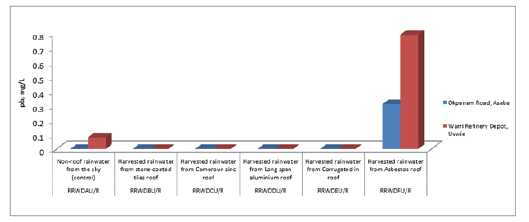
Figure 5:Cr (mg/L) values of analyzed samples in Delta State, Nigeria.

Figure 6:Fe (mg/L) values of analyzed samples in Delta State, Nigeria.

Figure 7:Zn (mg/L) values of analyzed samples in Delta State, Nigeria.
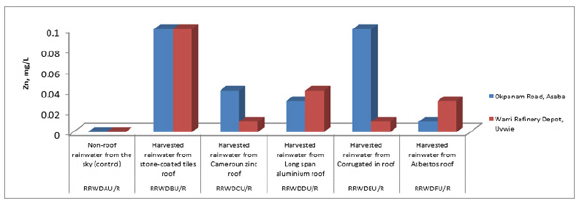
Figure 8:Al (mg/L) values of analyzed samples in Delta State, Nigeria.

Table 4:Water Quality Indices (WQI) of rooftop run-offs and non-roof rainwater (control) in Delta State, Nigeria.
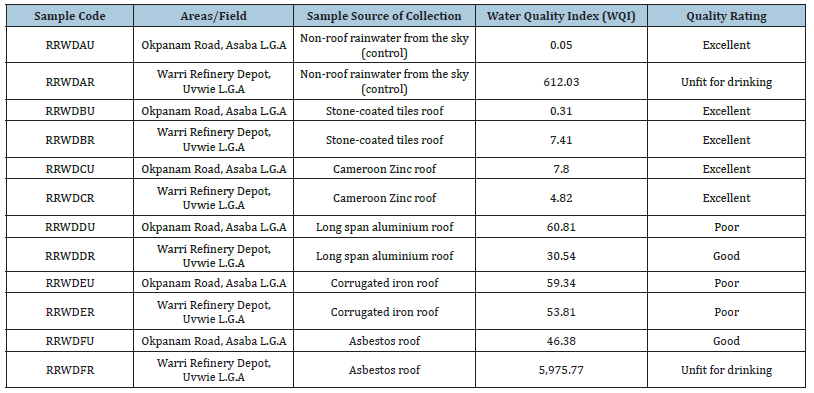
Physicochemical properties
pH: pH levels of non-roof harvested rainwater in Okpanam Road, Asaba local government area and Warri Refinery Depot, Ekpan Community, Uvwie L.G.A of Delta State were 7.30±0.40 (slight alkalinity) and 6.60±0.30 (slight acidity) respectively (Table 1 & 2) and Figure 2 above. Roofs run-offs harvested rainwater from Cameroon zinc and long span aluminium roofs had pH mean values ranging from 6.40±0.40-6.80±0.10 (slightly acidic). However, corrugated iron roof, asbestos roof and stone-coated tiles roof of 7.30±0.20-8.30±0.20 (slightly alkalinity) in Okpanam Road, Asaba while Warri Refinery Depot, Ekpan Community, Uvwie) had pH values of 7.40±0.30-8.80±0.70 for Cameroon zinc, long span aluminium, corrugated iron, asbestos and stone-coated tiles roofs which showed alkalinity as shown in Table 1-2 & Figure 2 above. The pH values of the non-roof rainwater (control) in Warri Refinery Depot, Ekpan Community, Uvwie and in Okpanam Road, Asaba local government area when compared with the air quality assessment values, it showed that, there was significant difference (P<0.05) in the results obtained as shown in the asbestos, corrugated iron, stone-coated tiles roofs in both areas and Cameroon zinc roof, long span aluminium roof indicating increase and decrease influence of flared gases, debris, silt and vehicular emissions in the atmosphere. The mean concentration of pH in rainwater samples from roof run-offs as recorded by the earlier studies reported 6.50±0.10- 6.60±0.20, 6.00±0.30-6.50±0.20, 6.2-7.6 for rainwater samples in Rivers State and Imo State respectively [1,5,20]. Findings by Moses et al also reported harvested rainwater to be slightly acidic in Uyo, Akwa Ibom State [21] and the study of Ojo in Akure, Ondo State [19] which showed slight acidity and these results were not in total supports with the values obtained in this study. All the values for pH concentrations were within the set standard except for asbestos and corrugated iron roof (rural) were above the limits of 6.5-8.5 for drinking water by NSDWQ, WHO and USEPA [40-42] as shown in Tables 1 & 2 above.
Electrical conductivity: Electrical conductivity levels gave mean values of 35.70±8.51 and 62.00±4.58μՏ/cm respectively for non-roof rainwater (control) in both areas of Delta State. Roofs runoffs harvested rainwater had electrical conductivity mean values ranging from 19.30±4.16-55.70±17.56μՏ/cm in Okpanam Road, Asaba L.G.A and 28.00±3.61-147.60±44.52μՏ/cm in Warri Refinery Depot, Ekpan Community, Uvwie local government area which were of low values as shown in Table 1 & 2 and Figure 3 above. The roofs run-offs when compared with the non-roof harvested rainwater, it was observed that, there was significant difference (p<0.05) in the obtained results in both areas and was seen in the asbestos roof which had the highest conductivity in Warri Refinery Depot, Ekpan Community, Uvwie and stone-coated tiles roof both areas of the state. These results were also in support with the findings by Nicholas & Ukoha [5], Ojo [19]; Emerole et al. [20]; Moses et al. [21], Waziri et al. [37] who reported a low degree of electrical conductivity in harvested rainwater samples from Akure, Ondo State; Owerri, Imo State; Maiduguri and Uyo, Akwa Ibom State respectively. The values obtained were all below the permissible limits of 1000-1200μՏ/cm for drinking water by NSDWQ, WHO and USEPA [40-42] as shown in Table 1 & 2 above.
Nitrate: Nitrate levels of non-roof rainwater (control) gave mean values of 0.05±0.01 and 0.07±0.00mg/L respectively in the urban and rural areas of Delta State. Roofs run-offs harvested rainwater from Cameroon zinc, long span aluminium, corrugated iron, asbestos and stone-coated tiles had nitrate mean values ranging from 0.04±0.00-0.13±0.03mg/L in the urban area and 0.06- 0.19mg/L in the rural area as shown in Table 1 & 2. Comparing the results of the roofs run-offs with the non-roof harvested rainwater (control), it was observed that there was little influence on the rainwater quality mainly from atmospheric pollution and exhaust gas from vehicles that could be transferred into the harvested rainwater from the rooftop run-offs which had lesser effect on the sampled rainwater quality. The values obtained were below the permissible limits of 15-50mg/L for drinking water by NSDWQ, WHO and USEPA [40-42].
Sulphate: Mean sulphate concentrations of non-roof rainwater (control) in both areas of Delta State were 0.11±0.03 and 0.13±0.02mg/L respectively. Roofs run-offs harvested rainwater from long span aluminium, stone-coated tiles, asbestos, Cameroon zinc and corrugated iron roofs had mean values ranging from 0.10±0.02-0.13±0.04mg/L in the urban area and 0.12-0.64mg/L in the rural area as shown in Table 1 & 2. Comparing the results of the roofs run-offs with the non-roof harvested rainwater (control), it shows that, there was significant difference (p<0.05) in the results obtained was due to particulate matters produced during gas flaring and vehicular emissions that could contribute deposition present in the harvested rainwater. The sulphate values of harvested rainwater obtained were within and below the permissible limits of 100-250mg/L for drinking water by NSDWQ [40], WHO [41] & USEPA [42] as shown in Table 1& 2 above.
Coliform level: E. coli was not detected in any of the analysed samples in both areas of Delta State as shown in Table 1 & 2 above. The coliform level of the harvested rainwater in this study was within the permissible limits of 0cfu/mL for drinking water by NSDWQ [40], WHO [41] & USEPA [42].
Heavy metals: Heavy metals concentrations for non-roof rainwater indicate the absence of Pb and Cr in Okpanam Road, Asaba local government area and Fe, Zn and Al in the Okpanam Road, Asaba local government area (urban) whereas Cr (0.03mg/L) and 0.08mg/L for Pb were found in Warri Refinery Depot, Ekpan Community, Uvwie L.G.A samples of the rural area in the non-roof harvested rainwater (control) as shown in Table 1-2 & Figure 4-8. Earlier findings showed that, there was no detection of Pb, Cr and Al in the analyzed direct harvested rainwater from the sky (control) while Fe (0.01±0.00-0.02±0.01 mg/L) and Zn (0.01±0.00- 0.02±0.00mg/L) in the urban and rural areas of Rivers State respectively [5] and these results were not in total supports with the values obtained in the harvested rainwater in this study. Roofs run-offs of long span aluminium, corrugated iron, stone-coated tiles and Cameroon zinc roofs had no detection of Pb and Cr in the harvested rainwater. Asbestos roof had Pb values of 0.79 (urban) and 0.31(Warri) while Cr had 0.06 (urban) and 0.05 (Warri). Long span aluminium roof had highest mean values of 0.35-0.81mg/L in both areas for Al and corrugated iron roof also had high mean values of 0.71-0.78mg/L in the urban and rural areas, Cameroon zinc had 0.05-0.06mg/L for Al in both areas and stone-coated tiles roof had 0.09mg/L for Al in the rural area as shown in as shown in Table 1-2 & Figure 4-8. There was no detection of Al in asbestos roofs in the urban and rural areas as shown in Tables 4.41-4.46. Comparing the roof run-offs harvested rainwater with the metal concentrations (mg/kg) of digested roofs gave 0.00-31.84 (Pb), 0.00-43.45 (Al), 39.22-63.78 (Fe), 0.59-7.04 (Zn) and 1.87-6.20 (Cr) as shown in Table 3, there was an indication of leaching of the heavy metals from the roof types into the rainwater quality. Findings reported Okudo et al. gave higher concentrations of Pb (Emene: 0.58±0.11and Iva Valley: 0.48±0.04) and Cr (Emene: 0.10±0.02) in rainwater samples from Enugu State [6]. Nanji et al. also gave higher values of chromium in the road run-offs rainwater in Nsukka, Enugu State [7]. Nicholas & Ukoha [5] also reported higher values of heavy metals in rainwater samples in Rivers and Imo State, Nigeria. Emerole et al. also reported heavy metals in direct rainwater and roof run-offs harvested rainwater (mg/L) of Fe 2.12±1.17, Al 1.70±1.83 and Pb 0.44±0.36, which were of higher concentrations from Owerri, Imo State [20] and were in supports with the values in this study. The values obtained were within the set limits for drinking water in some parameters in both areas except for non-roof rainwater (control) for Pb in Warri and in long span aluminium roof and corrugated iron roof in the urban and areas for Al, asbestos roof (both areas) for Pb and Cr for Okpanam Road, Asaba local government area which were above the permissible limits for drinking water of 0.30mg/L, 0.01mg/L, 0.05mg/L and 0.1-0.2mg/L for Fe, Pb, Cr and Al respectively for drinking water by NSDWQ, WHO and USEPA [40-42].
Water Quality Index (WQI) ratings
The results of the Water Quality Index (WQI) ratings, when compared with the NSDWQ [40], WHO [41] & ICMR [29] set standards gave the following; Non-roof harvested rainwater (control, Okpanam Road, Asaba local government area), Cameroon zinc roof (Warri Refinery Depot) and (Okpanam Road, Asaba) and stone-coated tile roof (Warri Refinery Depot) and (Okpanam Road, Asaba local government area) were classified as excellent water quality, and it is suitable for drinking, irrigation and industrial usages. Harvested rainwater from long span aluminium roof (Okpanam Road, Asaba) was rated good water quality, and it is fit for domestic, irrigation and industrial usages and not potable usages. Rainwater from a long span aluminium roof (Warri Refinery Depot, Ekpan Community, Uvwie L.G.A) and corrugated iron roof (Warri Refinery Depot) and (Okpanam Road, Asaba) and it is suitable for domestic, irrigation and industrial usage. Non-roof harvested rainwater (control, Warri Refinery Depot, Warri) and asbestos roof in both areas were rated unfit for drinking, and it is restricted to use for irrigation purposes as shown in Table 4 above.
Conclusion/Recommendation
In this study, the concentrations of some heavy metals in the roof run-offs and non-roof harvested rainwater were seen to be within and above the set limits by NDSWQ, WHO and USEPA due to the possibility of the industrial activities of these areas affecting the roof type component thus causing leaching. It was concluded that, rainwater should be treated before drinking because, there is a tendency for industrial activity, traffic emissions and component used in producing the roof types to have an effect on the rainwater quality. Governments and other stakeholders should create awareness for the people on the need to treat and drink clean water. Monitoring and evaluation of the environment should be done regularly by the relevant government agencies.
References
- Nicholas ES, Ukoha PO (2024) Analysis of the impact of Cameroun zinc, stone-coated tiles, asbestos, corrugated iron roofs and galvanized iron tank on harvested rainwater in south-south, Rivers State, Nigeria using water quality index. Journal of Chemical Society of Nigeria 49(1): 039-055.
- Marszalek A, Affek K, Zaleska-Radziwill M, Dudziak M (2024) Integrated ozonation and photocatalysis to remove pollutants for reuse rainwater. Sustainability 16(13): 5352.
- RAIN-Rainwater Harvesting Implementation Network (2008) Water quality guidelines: Version 1, Water Management, Amsterdam, Netherlands.
- Kugedera AT, Letticia KK, George N, Ronald M (2024) Evaluating effects of selected water conservation techniques and manure on sorghum yields and rainwater use efficiency in dry region of Zimbabwe. Heliyon 10(12): E33032.
- Nicholas ES, Ukoha PO (2023) Evaluation of the effect of different conventional roof types and industrial activity on harvested rainwater in southern Nigeria. Journal of Discover Water 3: 12.
- Okudo CC, Ekere N R, Okoye COB (2023) Quality assessment of non-roof harvested rainwater in industrial layouts of Enugu State, South East, Nigeria. Applied Water Science 13: 116.
- Nnaji CC, Chibueze CV, Mama CN, Alum OL, Afangideh CB (2023) Impact of anthropogenic and environmental conditions on surface run-off quality: A case study of Nsukka, Eastern Nigeria. International Journal of Environmental Science and Technology 20: 12351-12362.
- Prieto-Jimenez D, Oviedo-Ocana ER, Gomez-Isidro S, Domínguez IC (2024) A multicriteria decision analysis for selecting rainwater harvesting systems in rural areas: A tool for developing countries. Environ Sci Pollu Res 31: 42476-42491.
- Makarram MMT, Kafy AA, Rukiya OU, Almulhim AI, Das A, et al. (2023) Perception of coastal citizens on the prospect of community-based rainwater harvesting system for sustainable water resource management. Resour Conserv Recycl 198: 107196.
- Villatane AB, Ronda AC, Pirani LSR, Picone AL, Lucchi LD, et al. (2023) Microplastics and anthropogenic debris in rainwater from Bahia Bianca, Argentina. Heliyon 9(6): e17028.
- Mazurkiewicz K, Jez-Walkowiak J, Michalkiewicz M (2022) Physicochemical and microbiological quality of rainwater harvested in underground retention tanks. Sci Total Environ 814: 152701.
- Uwineza A, Irie M (2022) Flood analysis for estimating the impact of rainwater harvesting system installation using hydrological models. Case study: Nyabugogo valley, Kigali. Desert Studies 32(S): 145-149.
- Foupouagnini A , Ako AA, Mengnjo JW, Eneke G, Ndjama G, et al. (2022) Rainwater quality in some urban and rural sites of Cameroon (Central Africa). New Prospects in Environmental Geosciences and Hydrogeosciences, Springer Cham, Switzerland.
- Ombeni JM, Malugu MT, William JSM (2022) Estimation of storage tank capacities for different roofing areas for rainwater harvesting in Dodoma urban, Tanzania Tanzan. J Eng Technol 41(2): 109-120.
- Deng Y (2021) Pollution in rainwater harvesting: A challenge for sustainability and resilience of urban agriculture. J Hazard Mater Iett 2: 100037.
- Vlastos D, Antonopoulou M, Lavranou A, Efthimious I, Dailianis S, et al. (2019) Assessment of the toxic potential of rainwater precipitation: First evidence from a case study in three Greek Cities. Sci Total Environ 648: 1323-1332.
- Monika Z, Justyna Z, Dorota P, Daniel S (2020) The quality of rainwater collected from roofs and the possibility of its economic use. Resources 9(2): 12.
- Owusu A, Asante R (2020) Rainwater harvesting and primary uses among rural communities in Ghana. Jour Water Sanit. Hyg Dev 10(3): 503-511.
- Ojo OM (2019) Effects of roofing materials on harvested rainwater quality. Journal Applied Science and Environment Management 23(4): 735-738.
- Emerole CO, Emekaraoha M, Emerole CG (2015) Quality of harvested rainwater in Owerri, Imo State, Nigeria. International Journal of Multidisciplinary and Current Research 3: 1162-1166.
- Moses EA, Uwah II, Ebong GA (2016) Physico-chemical quality of harvested rainwater from some settlements in Uyo, Nigeria. American Chemical Science Journal 16(3): 1-9.
- Tikhatri D, Bhattarai SS (2023) Impact of climate change on water security and endorsing importance of rainwater harvesting technology in Nepal. American Journal of Environment and Climate (AJEC) 2(3): 24-32.
- Achadu OJ, Ako FE, Dalla CL (2013) Quality assessment of stored harvested rainwater in Wukari, North-Eastern Nigeria: impact of storage media. IOSR Journal of Environmental Science Toxicology and Food Technology 7(5): 25-32.
- Aladenola OO, Adeboye OB (2010) Assessing the potential for rainwater harvesting. Water Resource Management 24: 2129-2137.
- Mendez C, Klenzendorf B, Asfor B (2011) The effect of roofing materials on the quality of harvested rainwater. Journal of Water Research 45(5): 2049-2059.
- Ana A, Lidija T (2018) Analysis of basic physical-chemical parameters, nutrients and heavy metals content in surface Water of Small Catchment Area of Karašica and Vucica Rivers in Croatia. Environments 5(20): 1-27.
- Aralu CC, Okoye PA, Abugu HO, Eze CE (2022) Pollution and water quality of boreholes within unlined waste dumpsite in Nnewi, Nigeria. Discover Water 2: 1-12.
- Dinrifo RR, Babatunde SOE, Bankole YO, Demu QA (2010) Physicochemical properties of rainwater collected from some industrial areas of Lagos State Nigeria. Eur Jour Sci Res 41(3): 383-390.
- Indian Council of Medical Research (ICMR) (1975) Manual of standards of quality for drinking water supplies. Indian Council of Medical Research, New Delhi, India.
- Chukwuma EC, Nzediegwu C, Okpo FI, Ogbu KN (2013) Quality assessment of direct harvested rain water in parts of Anambra State, Nigeria. International Journal of Veterinary Science 1(1): 26-30.
- Eruola AO, Ufoegbune GC, Awomeso JA, Adeofun CO, Idowu OA, et al. (2010) Qualitative and quantitative assessment of rainwater harvesting from rooftop catchment: Case study of Oke-Lantoro Community in Abeokuta, Southwest Nigeria. Journal of Agricultural Science and Environment 10(2): 45-58.
- Olowoyo DN (2011) Physico-chemical characteristics of rainwater quality of Warri axis of Delta state in western Niger Delta region of Nigeria. Jour Environ Chem Ecotoxicol 3(12): 320-322.
- Ayenimo JG, Adekunle AS, Makinde WO, Ogunlusi GO (2006) Heavy metal fractionation in roof run-off in Ile-Ife, Nigeria. Int. Jour Environ Sci Technol 3(3): 221-227.
- Shyamala R, Shanthi M, Lalitha P (2008) Physico-chemical analysis of bore well water samples of Telungupalayam area in Coimbatore District Tamilnadu, India. J Chem 5(4): 924-929.
- Texas Commission on Environmental Quality Harvesting (2017) Storing, and treating rainwater for domestic indoor use, TCEQ, Texas, USA.
- Chukwuma EC, Nzediegwu C, Umeghalu EC, Ogbu KN (2012) Quality assessment of direct harvested rainwater in parts of Anambra State, Nigeria. Special Publication of the Nigerian Association of Hydrological Sciences, pp. 201-207.
- Waziri M, Akinnniyi JA, Ogbodo OU (2012) Assessment of the physicochemical characteristics of rain and run-off water in University of Maiduguri-Nigeria Staff quarters. American Journal of Scientific Industrial Research 3(2): 99-102.
- Eroksuz E, Rahman A (2010) Rainwater tanks in multi-unit buildings: A case study for three Australian Cities Res Conserv Recycl 54(12): 1449-1452.
- Gardner T, Ahmed W, Toze S (2011) Microbiological quality of roof harvested rainwater and health risks: A review. Jour Environ Qual 40(1): 13-21.
- Nigeria Standard for Drinking Water Standard Nigeria standard for drinking water quality NSDWQ (2015) Nigerian industrial standard NIS-554-2015, Standard Organization of Nigeria, Nigeria, pp. 1-28.
- World Health Organization WHO (2011) Guidelines for drinking water quality, (4th edn), WHO, Geneva, Switzerland, pp. 472-475.
- United States Environmental Protection Agency (USEPA) (2012) Source water assessment. USEPA, Washington DC, USA.
- Association of Official Analytical Chemists AOAC (1998) Official method of analysis, (15th edn), Association of Official Analytical Chemists, Washington DC, USA.
- John De Zuane PE (1990) Handbook of drinking water quality: Standards and control. Van Nostrand-Reinhold Publisher, New York, USA.
- American Public Health Association APHA (2012) Standard methods for the examination of water and wastewater, (22nd edn), American Public Health Association, American Water Works Association, Water Environment Federation, Washington DC, USA.
- Boateng TK, Opoku F, Akoto O (2019) Heavy metal contamination assessment of groundwater quality: A case study of Oti landfill site, Kumasi. Appl Water Sci 9: 33.
- Noori ND (2020) Comparative analysis of weighted arithmetic and CCME Water Quality Index estimation methods, accuracy and representation. IOP Conf Ser Mater Sci Eng 737: 012174.
- Alum OL, Okoye COB (2020) Pollution status of major rivers in an agricultural belt in Eastern Nigeria. Journal of Environmental Monitoring Assessment 192(6): 393.
- Anjaneyulu Y (1994) Introduction to environmental science, BSB Publications, India, pp. 685-690.
- Chauhan A, Singh S (2010) Evaluation of Ganga water for drinking purpose by water quality index at Rishikesh, Uttarakhand, India, Report Opinion 2(9): 53-61.
- Chowdhury RM, Muntasir SY, Hossain MM (2012) Water quality index of water bodies along Faridpur-Barisal road in Bangladesh. Global Engineers Technologists Review 2(3): 1-8.
- Rao CS, Rao BS, Hariharan AVLNSH, Bharathi NM (2010) Determination of water quality index of some areas in Guntur district Andhra Pradesh. International Journal of Applied Biology and Pharmaceutical Technology 1(1): 79-86.
© 2024 © Eno-obong Sunday Nicholas. This is an open access article distributed under the terms of the Creative Commons Attribution License , which permits unrestricted use, distribution, and build upon your work non-commercially.
 a Creative Commons Attribution 4.0 International License. Based on a work at www.crimsonpublishers.com.
Best viewed in
a Creative Commons Attribution 4.0 International License. Based on a work at www.crimsonpublishers.com.
Best viewed in 







.jpg)






























 Editorial Board Registrations
Editorial Board Registrations Submit your Article
Submit your Article Refer a Friend
Refer a Friend Advertise With Us
Advertise With Us
.jpg)






.jpg)














.bmp)
.jpg)
.png)
.jpg)










.jpg)






.png)

.png)



.png)






